Downloads
Introduction
Good afternoon ladies and gentlemen and thank you for the opportunity to address the Business Leaders' Forum today.
It is just over a year since the Government announced measures to support the financial system, in the form of guarantees of banking system liabilities, and the first fiscal stimulus package; measures announced in response to what has become known as the Global Financial Crisis.
Today, one year on, the Australian economy is showing encouraging signs of recovery. It appears too that the policy responses by governments and central banks elsewhere in the world have supported global growth; there are early signs that the global economy is beginning to recover.
The large and more timely policy responses domestically have contributed to the Australian economy weathering the turmoil in the global economy better than most comparable countries (Chart 1).
Chart 1: GDP growth in advanced economies
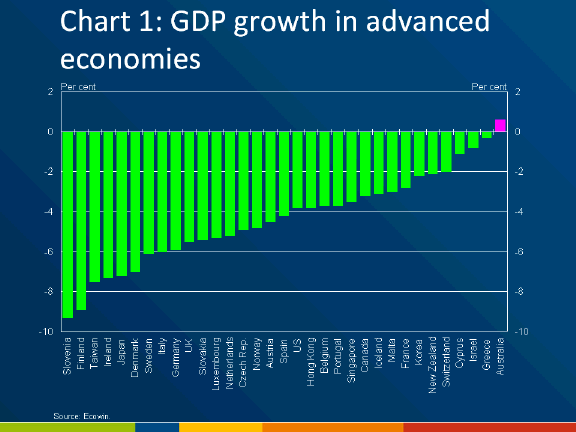
Source: Ecowin.
However, as important as those measures have been to the maintenance of aggregate demand in the face of the global recession – and especially in supporting employment – they are not what will drive growth over the medium to long term. Indeed, we expect that the peak impact of the fiscal stimulus (in the June quarter 2009) is already behind us. From the first quarter of 2010, fiscal policy will begin detracting from economic growth as the fiscal stimulus unwinds.
Today I'd like to talk about four longer term trends that had been strongly influencing economic outcomes in Australia before the onset of the Global Financial Crisis, and which are likely to become even more influential in the next growth period. Indeed, each of these four longer term trends is likely to have a profound impact on the Australian economy – and Australian society – for several decades to come.
My theme, in considering each of these four trends, is sustainability.
Four Key Forces Affecting the Australian Economy
As the Global Financial Crisis hit our shores, the Australian economy was in structural transition in response to four large, long term forces: (1) population ageing; (2) climate change adaptation and the prospect of climate change mitigation; (3) the information and communications technology revolution; and (4) the impact on Australia's terms-of-trade of the re-emergence, as global economic powers, of China and India.
Over the past year, the shockwaves from the global financial crisis have obscured the intensity and scale of these forces. But as growth resumes, they will re-assert themselves. And, as they do, the Australian economy will undergo a set of structural changes more profound than anything in its history.
Just how those structural changes play out depends critically on the quality of the policy settings and decisions taken today. None of the four forces I have identified need undermine economic, social or environmental sustainability. Indeed, with the right decisions, one can envisage a period of unprecedented prosperity; with less judicious decisions, however, we could experience an extended period of extreme volatility – with no growth path proving sustainable.
Population Ageing
Most of you will be familiar with the changing age structure of the Australian population, driven by the collapse in the birth rate in the 1960s and 1970s, as the baby boomers decided to have fewer children than their parents, and accentuated by increasing life expectancy.
To recap, the proportion of the population aged 65 and over has increased from 8 per cent in 1969 to around 13 per cent today. By 2049 we think this figure will rise to 22 per cent – a little over one in every five Australians being aged 65 or over 40 years from now. By any measure, this is a dramatic change in the age structure of the Australian population. Perhaps even more remarkable is the projection that, by 2049, 5 per cent of the population – one in twenty – will be aged 85 and over, compared with around 1.7 per cent of the population today.
As the population ages the share of the population making itself available for employment – what economists call the participation rate – will fall, increasing the dependency rate (which measures, broadly, the number of people not working per person in the labour force) and exerting a drag on potential per capita output growth. What many people might not realise is that over the past several decades, this same population ageing process has made a strong positive contribution to GDP per capita growth rates. That is because the proportion of the population of prime working age has been increasing through all of that period, boosting the participation rate.
The Global Financial Crisis hit the Australian economy just as the proportion of the population of prime working age was about to reach its highest level. By the time the Australian economy uses up all of the spare capacity generated by the recent slowdown, and gets back to potential output, we will already have passed that peak and be on the downward slide. (Chart 2)
Chart 2: Participation rate
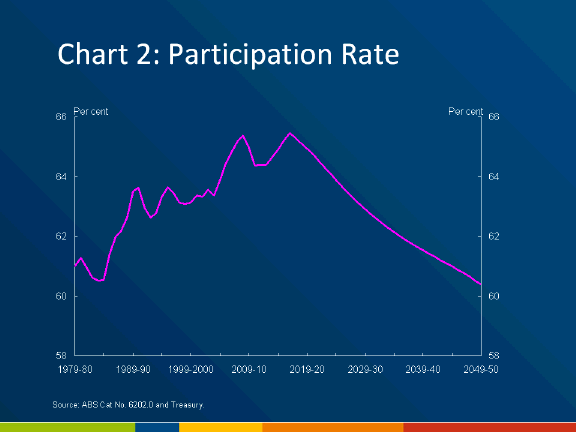
Source: ABS Cat No. 6202.0 and Treasury.
The looming prospect of this population slide, and its implications for GDP per capita performance, several years ago motivated an interest in policy reforms to drive stronger contributions from the other two 'Ps' of participation and productivity. Notwithstanding that motivation, in the years before the crisis hit, we were dealing with an extremely tight labour market, with skills in increasingly short supply, and productivity outcomes that had been disappointing. The case for securing better outcomes in workforce participation and labour productivity, already strong before the crisis hit, will be sharply more apparent after it has passed.
Until recently, we had been thinking about population dynamics in terms of ageing and a rising dependency ratio. But last month the Treasurer shone a light on a whole new dimension of our thinking when he announced that, since publishing the Intergenerational Report 2007, our long term projection for Australia's population had increased from 28.5 million in 2047 to more than 35 million people in 2049.
This 25 per cent increase in our 40 year projections reflects the combined effect of higher net overseas migration and a recent pick up in the fertility rate of Australian women.
Today's population is about 22 million. So we are now projecting an increase of 13 million people, or around 60 per cent, over the next 40 years.
A population expansion of this order has a host of implications for the Australian economy and society; and it raises a number of profound issues for economic policy.
First set of issues: Where will these 13 million people live – in our current major cities and regional centres or in cities we haven't yet even started to build? We have given this matter some thought in the Treasury. On quite reasonable assumptions, we can imagine Sydney and Melbourne growing from 4½ and 4 million people today to cities of almost 7 million. Brisbane will, we think, more than double in size, to be 4 million people 40 years from now. Among them, Sydney, Melbourne, Brisbane and Perth will have almost as many people as the entire Australian population today.
How will Sydney cope with a 54 per cent increase in its population, Melbourne a 74 per cent increase and Brisbane a 106 per cent increase? Surely not by continuing to expand their geographic footprints at the same
rate as in the past several decades. Surely not by loading more cars and trucks onto road networks that can't cope with today's traffic.
However our cities do cope, they will have to find ways of securing a sustainably higher level of investment in public infrastructure.
Second set of issues: What sorts of jobs will this larger population want? How will they acquire the skills they need to do those jobs? How will the location of the jobs be reconciled with preferences about where people want to live?
Third set of issues: What types of services will our governments of the future need to provide to their citizens, both young and old?
Fourth set of issues: Are Australia's natural resource endowments, including water, capable of sustaining a population of 35 million? What are the implications for environmental amenity of this sort of population growth? Must it mean an even greater loss of biodiversity – difficult as that might be to imagine, given our history of species extermination?
We don't know the answers to these questions, even though all of us would have opinions. My own opinion on the last of these sets of issues – and I must stress that it is a personal view, not to be taken as a Treasury view – is pessimistic. In the last decade, permits have been issued to allow the commercial slaughter of 49.6 million kangaroos in the last decade1 – primarily to give household pets a bit of variety in their diet. That is but one instance of a set of behaviours that suggests that with a population of 22 million people, we haven't managed to find accommodation with our environment. Our record has been poor and in my view we are not well placed to deal effectively with the environmental challenges posed by a population of 35 million.
Whether you share that pessimistic view or not, and whatever your opinions on the other sets of issues I have outlined, one thing on which we will all agree is that substantial additional investment, in both private and public infrastructure, economic and social, will be required to support our larger human population. We should also be able to agree that quite sophisticated infrastructure planning is going to be required if we are to address these questions in a way that improves the wellbeing of the Australian people in a sustainable way.
Climate Change
The second longer term force impacting the Australian economy is climate change. There are three dimensions to this issue that are of policy interest: how we adapt to a changing climate; how we intervene to mitigate the extent of climate change; and the consequences of those mitigation initiatives.
The science tells us that Australia's climate will change over the coming century. And while an already dry continent will become drier, there is good reason to consider that the impact will be quite different in different parts of the country.
The same science tells us that our climate will become more variable, with more extreme weather events affecting the places where people live.
Taking these things together, what might climate change adaptation mean for Australia?
Already stretched water resources are an issue. And in adapting to climate change, we will need to reconsider historical assessments of the more hospitable parts of the country: Does it make sense for our population to continue to be concentrated in the south eastern corner of the continent? How sustainable are traditional patterns of land use in already heavily populated areas?
We can predict that our urban infrastructure will be built to higher standards; that the building materials we use will be more energy efficient and designed to cope better with more extreme weather events. But this is just one example of a general proposition relating to climate change adaptation: it is capital-intensive; it implies higher levels of investment.
As far as climate change mitigation is concerned, all I want to say today is that the imposition of a price signal to reflect the negative externalities of greenhouse gas emissions is intended to cause a significant shift in the structure of the Australian and global economies over coming decades; quite possibly the largest structural adjustment in economic history. That is the point of doing it.
And this structural shift will also entail substantial new investments – in lower emission electricity generation sources and, more generally, in technology that will contribute to lower emissions in a variety of industries.
ICT revolution
The third key force I want to mention is the continuing impact of the diffusion of information and communications technologies.
I sometimes get the impression that some people believe that the ICT Revolution ended with the collapse of the 'dot-com' bubble earlier this decade.
Instead, there are very good reasons to believe that we have only just begun to see what the ICT Revolution promises.
The ICT revolution involves what is generally referred to as a 'general purpose technology'2. These tend to possess the following properties: wide scope for improvement and elaboration; applicability across a broad range of uses; potential for use in a wide variety of products and processes; and strong complementarities with existing or potential new technologies
Historically, the productivity gains of general purpose technologies have taken a long time to have their full effect, with much of it occurring some decades after the initial breakthroughs.3
What might this mean for Australia?
Well, for one thing, developments in information and communication technologies have already helped to reduce the 'tyranny of distance' that separates Australia from major global markets – a significant part of the historical explanation for our GDP per capita lagging that of the United States.
Of particular interest is what the ICT Revolution means for the tradability of services. And it could prove to be particularly important in facilitating a more sustainable pattern of population settlement on a continent of 35 million people.
Moreover, the ICT Revolution is likely to have profound implications for the way in which government services are provided to a rapidly growing aged population and, more generally, for the way in which citizens of all ages interact with their governments. This is something that has been at the front of mind of the tax review panel in its deliberations this past 18 months.
Like population and climate change, the ICT Revolution entails substantial additional investment.
The Re-emergence of China & India and Australia's Terms of Trade
The fourth long term force affecting the Australian economy is the re-emergence of China and India. In recent years I have spoken about the structural implications for the Australian economy of their strong contribution to the global demand for mineral commodities. That demand has supported a considerably higher level of our terms-of-trade. And it would be reasonable to consider that, while the Global Financial Crisis has taken some of the heat out of our export prices, we should get used to the idea that we could have structurally higher terms-of-trade for quite some time – possibly for several decades.
Standard economic theory suggests the following consequences of a sustained improvement in the terms-of-trade in an economy like ours:
- Output of the resources sector increases and output of the import-competing sectors, especially manufacturing, falls.
- The set of domestic consumption possibilities expands. In aggregate, Australians are better off, enjoying higher real national income. They demand more manufactures from the rest of the world.
- The volume of trade expands: volumes of both manufactured imports and resources exports increase
. - The resources sector employs a higher share of the economy's factors of production.
- Real wage rates from the perspective of employers – that is, producer real wage rates – fall. Consistently, labour's marginal and average products fall in all industries.4
- Capital productivity rises, and so too does the real return per unit of capital.
- Labour's share in GDP falls as the profit share increases.
- Because the structural change takes time to occur, there could be a temporary increase in the current account deficit, during a period in which national investment outpaces national saving. While import volumes might increase immediately, export volumes may even fall in the short term.
- The capital stock will increase in response to the higher real return on capital. This aggregate capital-deepening will not, however, be reflected in higher real wages; instead it will accentuate the structural adjustment in favour of capital-intensive production.5
Thus, standard economic theory tells us that if the terms-of-trade remain at high levels, not only will the resources sector command more capital and labour, manufacturing and other industries whose relative output prices are declining will command less, even as our total stock of capital expands. Furthermore, as the factors of production are reallocated, the pattern of growth will be characteristic of what is often referred to as a 'two speed economy'; and real wages growth and labour productivity growth will be weak – possibly even negative.
That last point might strike you as counter-intuitive. After all, when commodity prices accelerated from late 2003, demand for skilled labour also grew strongly; and as labour markets tightened, that labour was increasingly well rewarded, with strong nominal wages growth. Yet it is also true that the profit share increased strongly, just as the standard theory predicts. The important thing to keep in mind is that when the standard theory refers to real wages, it is deflating nominal wages not by consumer prices, but by producer (employer) prices. Thus, if you were to track the growth in average nominal wages in Australia over the past 10 years, and deflate these by the GDP deflator – a rough proxy for producer prices – you would find that there has been absolutely no growth at all. Real wages in Australia have been broadly flat for a decade. Indeed, since late 2003 they have actually trended down, just as the standard theory predicts.
You might have noticed that none of the impacts to which I have referred have relied on there being any movement in the nominal exchange rate. This is a rather important point. Many Australian manufacturers would be thinking that the reason they are feeling the squeeze from our higher terms of trade is that the exchange rate has appreciated. But even if the exchange rate were not to appreciate, they would eventually feel the squeeze because they would find it increasingly difficult over time to compete with the construction and resources sectors for the economy's factors of production – both labour and capital.
I want to emphasise that the issues raised here are not of merely passing, nor merely academic, interest. For policy makers, they will, over many years ahead, be of central concern.
China and India are only in the early stages of catching up with the living standards of the developed world (Chart 3), and this process could have a very long way to run.
Chart 3: Per capita GDP convergence
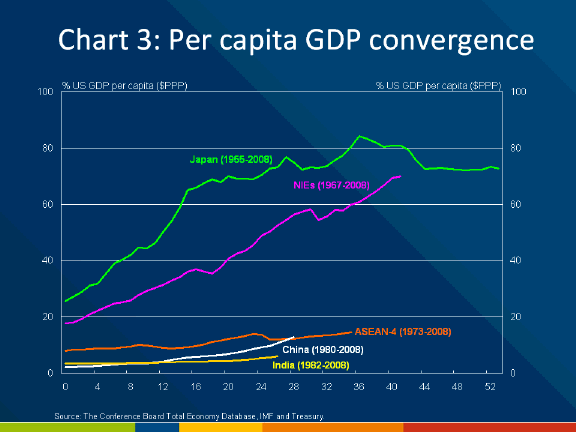
Source: The Conference Board Total Economy Database, IMF and Treasury.
While our terms of trade have been negatively affected by the global downturn (Chart 4), they remain well above their longer-run average. Indeed, based on the Budget forecasts, in 2012-13 the terms of trade are expected to be around 35 per cent above their 50-year average prior to the recent terms of trade boom.
Chart 4: Terms-of-trade
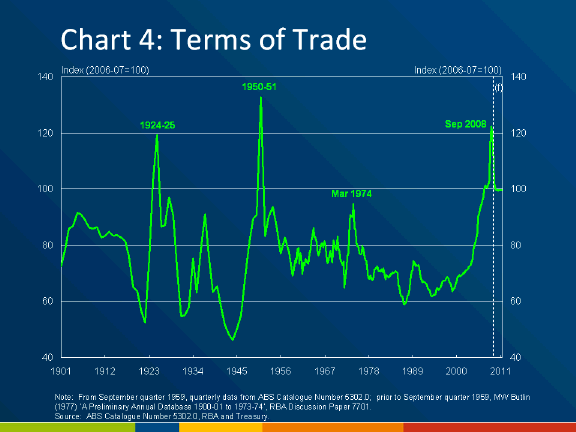
Note: From September quarter 1959, quarterly data from ABS Catalogue Number 5302.0; prior to September quarter 1959, MW Butlin (1977) 'A Preliminary Annual Database 1900-01 to 1973-74', RBA Discussion Paper 7701.
Source: ABS Catalogue Number 5302.0, RBA and Treasury.
The Budget medium term projections contain a 15 per cent decline in the terms-of-trade over the following decade – reflecting an assumed supply response to higher commodity prices. But even with this assumed further decline – in which we may, once again, prove to have been overly conservative – our terms-of-trade would remain well above the historical average.
And Australia is considered to have a high level of remaining reserves of key mineral commodities, with iron ore reserves currently expected to last another 65 years, black coal another 90 years, alumina another 85 years and brown coal another 500 years.6
To get the full benefit of the elevated terms-of-trade, the share of our factors of production allocated to the resource sector will need to increase.
But there may be even greater benefits to be had with policy responses that would, perhaps counter-intuitively, ameliorate the structural adjustments referred to so far. Two such responses, also derived from standard economic analysis, stand out for consideration.
First, some of the structural decline in manufacturing could be ameliorated by a sustained increase in the size of the labour force. Workforce participation reforms are significant here. In addition, as noted earlier, we have recently revised up considerably our population projections, due in large part to an elevated immigration program. The faster rate of population growth associated with higher immigration raises a number of policy issues to which I have already referred. But, like higher rates of workforce participation, it also changes the dynamics of the economy's probable adjustment to structurally higher terms-of-trade. In particular, it means that the resource sector's demand for Australia's factors of production need not necessarily come largely at the expense of manufacturing.7 The political economy of that adjustment path might be significantly less fraught; relative decline being easier to manage than absolute decline.
Second, there may be tax policy responses that can both support higher labour productivity and real wages and, coincidentally, ameliorate the extent of the structural adjustment associated with the resources boom. I'm not able to go into the details of such tax policy changes today. Suffice to say they are under active consideration by the tax review panel.
Where does this place Australia in 2050?
The coming decades will be times of great structural change:
- An older, larger population.
- A considerably larger mining sector, relatively smaller manufacturing and tourism sectors.
- Different sorts of cities, perhaps even different cities, different sorts of houses, a different pattern of population dispersion.
- A population more connected, electronically, to the rest of the world, but in important ways as far away as ever.
These changes will test the limits of at least some aspects of social and environmental sustainability. And they also raise big questions for those who, like me, take a keen interest in economic sustainability, including fiscal sustainability.
A common thread in the forces I have talked about is a higher level of investmen
t, lasting perhaps for some decades. That means that the Australian economy will be importing capital – and therefore running a substantial current account deficit – for many decades to come.
Sustainability of the Current Account Deficit
Australia has a long history of current account deficits (Chart 5), reflecting the need to supplement the savings of a relatively small population to take advantage of an abundance of investment opportunities.
Chart 5: Australia's Current Account Balance 1901-2009
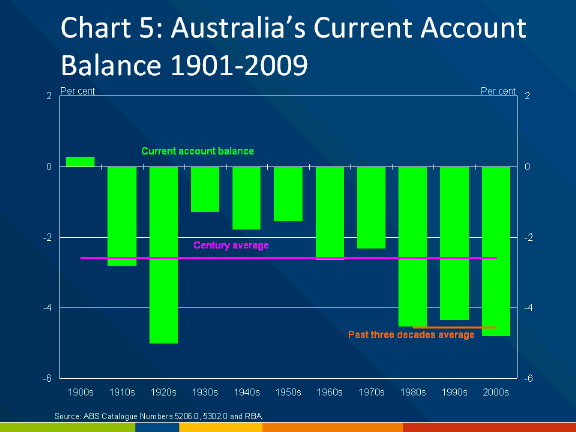
Source: ABS Catalogue Numbers 5206.0, 5302.0 and RBA.
From a national accounting perspective, a current account deficit means that a country's investment exceeds its saving. It follows that sceptical people will tend to interpret a current account deficit as either a deficiency of national saving or an excess of national investment.
The adequacy of Australia's national saving has been the focus of significant public policy debate over recent decades. Concern about Australia's national saving rate was one motivator of the Superannuation Guarantee scheme, and it has been a motivator also of the fiscal consolidation and medium-term fiscal strategies of successive governments since the mid-1980s.
Over the course of the past two decades, Australia's national saving rate has increased relative to most other advanced economies. It is now around the average of OECD countries (Chart 6). The projected deterioration of the fiscal positions of Australian governments due to demographic factors (as set out in Intergenerational Reports) over the medium to long term will, other things equal, lower national saving over this period. It is possible that, at some point in the next several decades, governments may judge that further policy action is required to support national saving.
Chart 6: Australia's National Saving
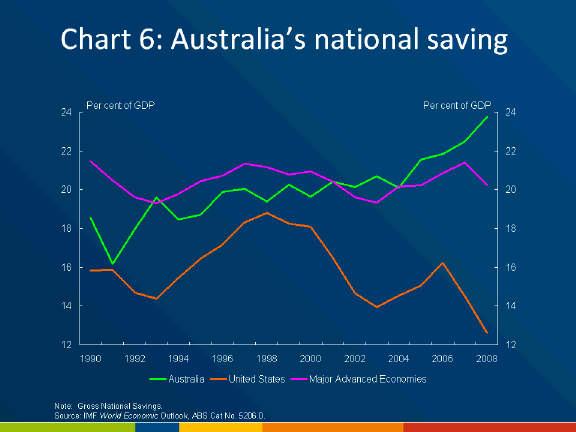
Note: Gross National Savings.
Source: IMF World Economic Outlook, ABS Cat No. 5206.0.
But the bigger story relates to national investment. Australia's investment rate has consistently been above the average of OECD countries (Chart 7). This primarily reflects our relatively large, capital-intensive, mining sector, and a level of dwelling investment that is slightly above average.
It would be reasonable to conclude, therefore, that Australia's sustained current account deficits reflect high national investment rather than low national saving. And, for the reasons I have detailed here today, national investment levels could remain elevated for several decades.
Chart 7: Australia's National Investment
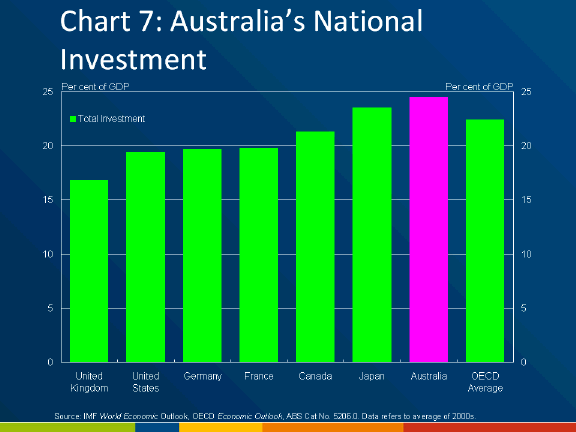
Source: IMF World Economic Outlook, OECD Economic Outlook, ABS Cat No. 5206.0. Data refers to average of 2000s.
Financial Crises, Current Account Deficits and 'Consenting Adults'
I have been asked on many occasions in recent weeks about what the Global Financial Crisis means for the sustainability of our current account deficit. I will conclude with some reflections on this question.
It is clear that a proximate cause of the Global Financial Crisis was prolonged, large global macroeconomic imbalances.
The word 'imbalances' should not be confused with the term 'current account balances'. But the latter should be the starting point of enquiry. Equally, it would be too sanguine to suggest that a current account deficit that reflects high levels of private sector investment is of no concern.
The crisis should make us less sanguine about the quality of the judgements being made by 'consenting adults' in deciding how much to invest, and where it should be allocated. It has brought into question the implicit assumption that global capital markets never fail.
The Asian Financial Crisis a decade earlier had illustrated what could happen when a sudden loss of access to global capital markets for a capital importing country requires a sharp contraction in, indeed a reversal of, its current account deficit. A similar drama is now playing out, on a much larger scale, in the United States. The United States authorities got their 'wake-up' call when the portfolio equity flows that underpinned the 'dot-com' bubble dried up, overnight, at the start of this decade. Evidently, instead of waking up, they hit the 'snooze' button.
It is clear, in retrospect, that Australia's key vulnerability in financing its current account deficit has been the 'roll-over risk' associated with its financial intermediaries' borrowing in global short term money markets. Indeed, well before the crisis hit, financial intermediaries' heavy use of this borrowing had featured in a number of Reserve Bank Financial Stability Reviews, and 'roll-over risk' had been highlighted in the International Monetary Fund's 2006 Financial Sector Assessment Program report on Australia.
Yet it would be difficult, I suggest, to construct a more demanding stress test of this vulnerability that that posed by the Global Financial Crisis. The fact of our having passed that test provides grounds for some confidence, though certainly not complacency, in the strength of our policy frameworks and decision-making.
More generally, the Australian economy might better be viewed as illustrating what needs to be done – in respect of macroeconomic policy frameworks and regulatory frameworks and institutions – to be able to sustain a sizeable current account deficit. I'm not being complacent; far from it. I feel comfortable venturing the proposition only because we have, over several decades now, taken the matter of current account sustainability so seriously.
Conclusion
As we emerge from the shadow of the Global Financial Crisis, several strong forces that had been acting on the Australian economy as that crisis hit our shores will come more sharply into focus.
Population ageing will have an even more pronounced impact on GDP per capita growth over the coming decades; and the prospect of a much larger than previously forecast population raises some fundamental questions about where Australians of the future will live, how governments will interface with them, and the large scale economic and social infrastructure investments that will be required to sustain economic and social activity. A larger population also raises some confronting questions relating to environmental sustainability.
Climate change adaptation and the response to mitigation strategies will have profound implications for the pattern of human settlement on this driest inhabited continent on earth. Taken together, these forces could produce the largest structural adjustment in our economic history. And they, too, will involve a higher rate of investment.
The ICT revolution is changing the shape of the Australian economy. It holds out the prospect of a significant revolution in the way government services are provided to a rapidly growing aged population; and for government service provision in general. It, too, implies a period of stronger national investment.
And then there is the re-emergence of China and India which, because of its implications for global commodities demand, has conferred on Australia a large boost to its real wealth; but, at the same time, set up a set of structural adjustments that will challenge policy makers for decades. And it, too, implies a very substantial increase in our rate of investment.
Had these forces hit the Australian economy of the 1960s,
1970s or 1980s, the prospects of our finding a sustainable growth path would have been remote. In particular, the current account would quickly have emerged as a binding constraint on our capacity to access the higher levels of investment capital needed to adjust. But these forces are hitting now; at a time when we have implemented 25 years of economic reforms; when the Australian economy has just demonstrated to the rest of the world that, for some time now, it has quite possibly been the best governed, most flexible, most resilient of all industrialised economies; when there is unprecedented global interest in us; and when there is, domestically, a strong appetite for further policy change.
Yet all of these changes will test the limits of sustainability; economic, social and environmental. It will only be by recognising those limits and adjusting policy accordingly that this generation will be able to say with confidence that it will hand to its children and grandchildren an even higher level of wellbeing; an even greater capability to choose lives of value.
1 http://www.environment.gov.au/biodiversity/trade-use/wild-harvest/kangaroo/stats.html
2 Lipsey, Bekar and Carlaw (1998).
3 David and Wright (1999).
4 Stolper-Samuelson (1941). An intuitive explanation is as follows: Starting from a position in which labour and capital are fully employed, the output of the more capital-intensive sector expands, and the output of the other sector contracts. Suppose this were to happen with no change in the capital intensity of production in either sector. Then the expanding sector would be requiring additional factor inputs in a higher proportion of capital to labour than they would be released from the contracting sector. The only way this can happen is if labour becomes unemployed; that is, if some of the labour released from the labour-intensive sector is not re-employed in the expanding capital-intensive sector. A real wage reduction ensures that labour remains fully employed. It achieves this by encouraging both sectors to reduce their capital intensity of production.
5 Rybczynski (1955).
6 Geoscience Australia.
7 This, too, is an implication of Rybczynski (1955).